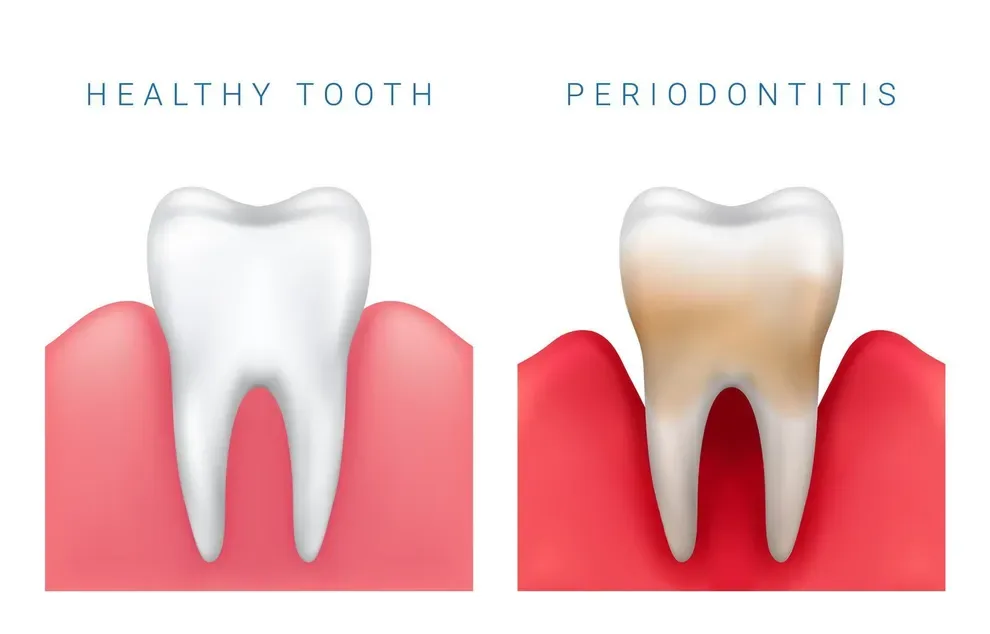US Gum Disease & Gingivitis Statistics

Table of Contents
- US Dental Health & Gum Disease
- Gingivitis Often Goes Unnoticed
- Periodontitis
- Eliminating Gum Disease Starts at Home
Gum disease is a huge problem in the US, and it often goes untreated. While early stages of gingivitis might not be noticeable, later stages can cause serious health and dental problems, including shifting teeth and trouble eating.
Dental Health & Gum Disease in the United States
The term periodontal disease describes diseases of the gums that can cause damage to the rest of the mouth, especially the teeth and jawbone, when they reach advanced stages. Millions of people in the United States have some form of periodontal disease, but they may not realize they have a gum disease like gingivitis. Many worry about the cost of treating this disease.
According to the Centers for Disease Control and Prevention (CDC), nearly half of adults in the US who are 30 or older have some form of gum disease. The risk of developing this condition increases with age. It tends to be more common in men than women, cause more health harm to low-income individuals, especially those who are below the poverty level, and impact current smokers more than non-smokers or former smokers.
Gingivitis: Mild or Moderate Gum Disease Often Goes Unnoticed
Gingivitis is the first stage of gum disease, which is caused by bacteria in the mouth infecting a tooth or the gums near a tooth, leading to inflammation.
Over the course of a day, the bacteria in your mouth will form a film called plaque that collects on the surface of your teeth. Regularly brushing and flossing at least twice per day can reduce the amount of plaque on your teeth. Visiting your dentist once or twice per year for a cleaning and examination can remove problem areas, including tartar (calculus) buildup caused by the collection of plaque in specific locations on or around your teeth. However, even if you get regular cleanings and have a good oral hygiene routine, you may develop gingivitis when a tooth becomes infected.
If you go to the dentist regularly for a checkup and cleaning, they will be able to see signs of gingivitis forming and provide any additional treatment needed to remove tartar and eliminate gum disease. Unfortunately, too many people in the US do not get the dental treatment they need to reduce or stop gingivitis from getting worse. [A household survey conducted in 2015 across the US](https://www.ada.org/~/media/ADA/Science and Research/HPI/OralHealthWell-Being-StateFacts/US-Oral-Health-Well-Being.pdf?la=en) found that 77 percent of adults said they would visit a dentist within the next year, but only 37 percent had actually visited a dentist in the past year.
The CDC’s lists the following gum disease statistics:
Over 47 percent of adults in the United States, ages 30 and older, have some form of periodontal disease.
About 30 percent of adults have moderate gum disease.
Approximately 8.5 percent of adults have severe gum disease.
Over 70 percent of older adults, 65 and older, have some form of periodontal disease.
More than 56 percent of men and 38 percent of women have periodontal disease.
Nearly 65 percent of current smokers have periodontal disease.
With about 4 in 10 adults in the US developing gum disease between 2009 and 2014, it is important to understand the early warning signs of gum disease, so you can seek treatment. These are signs that you may be developing gum disease:
A bad taste in your mouth that will not go away
Bad breath that does not go away after brushing your teeth
New sensitivity to temperature or sugar in your teeth
Painful chewing
Tender gums
Bleeding gums, including after you brush your teeth
According to the National Institute of Dental & Craniofacial Research older adults, Black and Hispanic adults, current smokers, and those with lower incomes and less education are more likely to have periodontal disease.
Periodontitis: Severe Gum Disease Can Lead to Poor Teeth, Tooth Loss & Bone Disease
Treating gingivitis is important, or it can develop into more severe gum disease, including periodontitis. The signs of gingivitis include gum pain or sensitivity, tooth sensitivity, gum inflammation, and bleeding. Periodontitis leads to more serious outcomes that can take longer to heal.
These are signs of periodontitis:
Loose teeth
Receding gum line
Pockets between teeth and gums (measured during a dental examination)
Sores forming on the inside of the mouth
Changes in the way your teeth fit together (teeth shifting)
Changes in the fit of partial dentures
Treatment for periodontitis may involve root scaling and planing, flap surgery, antibiotic prescriptions, removing problematic teeth, root canals, and treating bone loss in the jaw with grafts. To determine how serious periodontitis is, your dentist will use x-rays and a visual exam to look at changes in your teeth, roots, and jawbone.
An oral exam includes measuring the pockets between your gums and teeth. Healthy gums have pockets between 1 and 3 millimeters, and larger pockets can indicate levels of gum disease. You may also be referred to a periodontist, who specializes in treating periodontal disease.
The CDC found that severe gum disease, or periodontitis, affects about 9 percent of adults in the US. About 5.08 percent of adults between 20 and 64 years old have some form of moderate or severe periodontal disease, and 8.52 percent have any type of gum disease. This can lead to tooth decay, which one in four adults in the US has.
Thanks to improvements in medical and dental treatment since the mid-20th century, complete tooth loss in older adults has been significantly reduced. Still, people 65 and older are at higher risk of developing serious gum disease and losing teeth.
Eliminating Gum Disease Starts at Home
Most people develop gum disease at some point in their lives. If you do notice signs of gingivitis, there is no reason to feel bad. Even with a good oral hygiene routine, you can develop gingivitis.
Maintain your regular oral health routine, and contact your dentist for help managing gingivitis, so that it does not turn into worsened periodontitis. Your dentist can recommend some at-home treatments to improve your oral health, and get you in for an oral exam and dental cleaning if necessary.
At home, you can reduce your risk of developing gum disease by brushing and flossing your teeth at least twice per day. If you do not have fluoridated water, or prefer not to drink fluoridated water, use a fluoride toothpaste to reduce bacterial growth that leads to cavities and gum infections. Flossing removes food and plaque from between the teeth, but you may also benefit from a different type of cleaning like using interdental brushes or a water flosser.
Changing lifestyle habits, like reducing how much refined sugar is in your diet and quitting smoking, can also improve your oral health and reduce your risk of gum disease.
